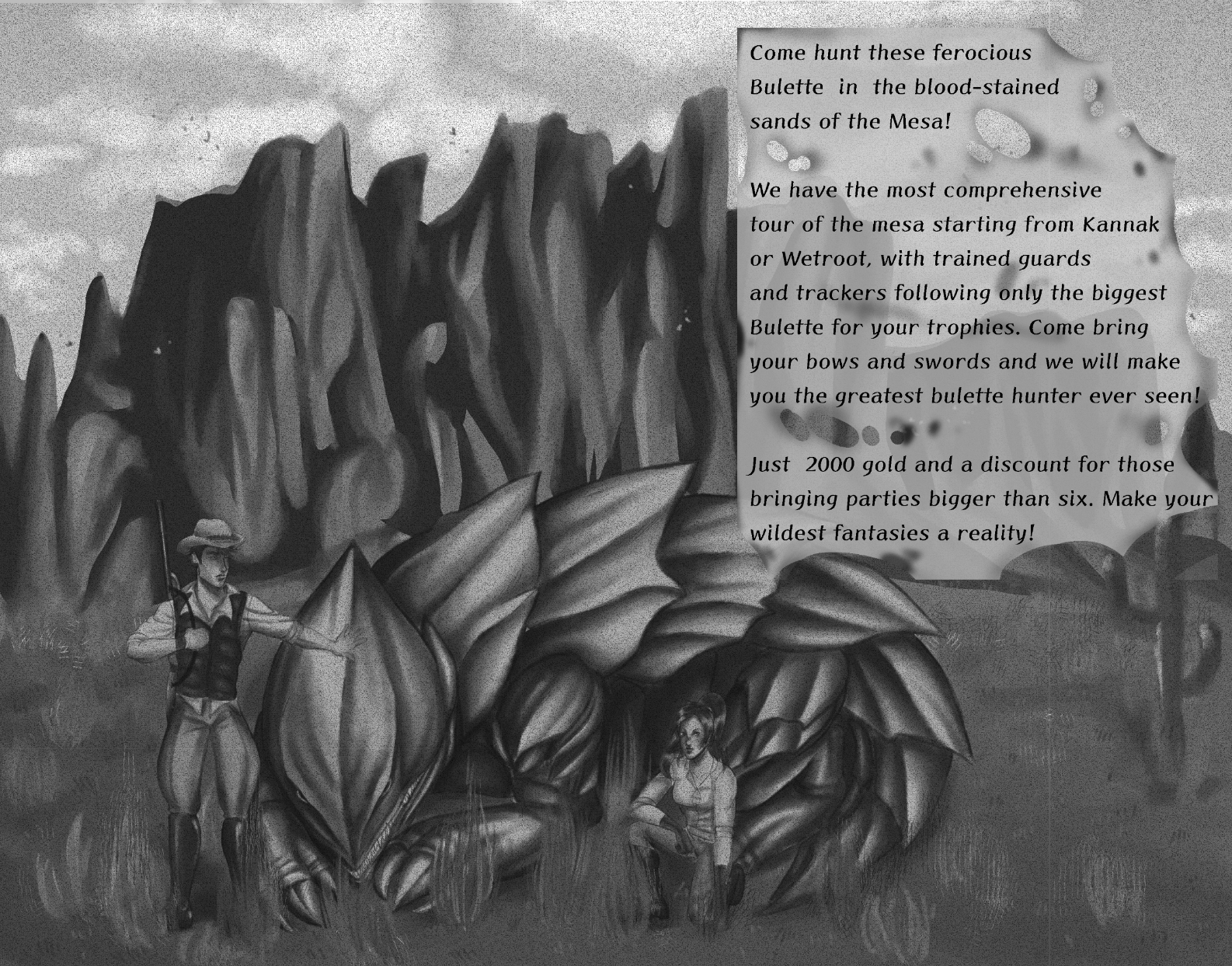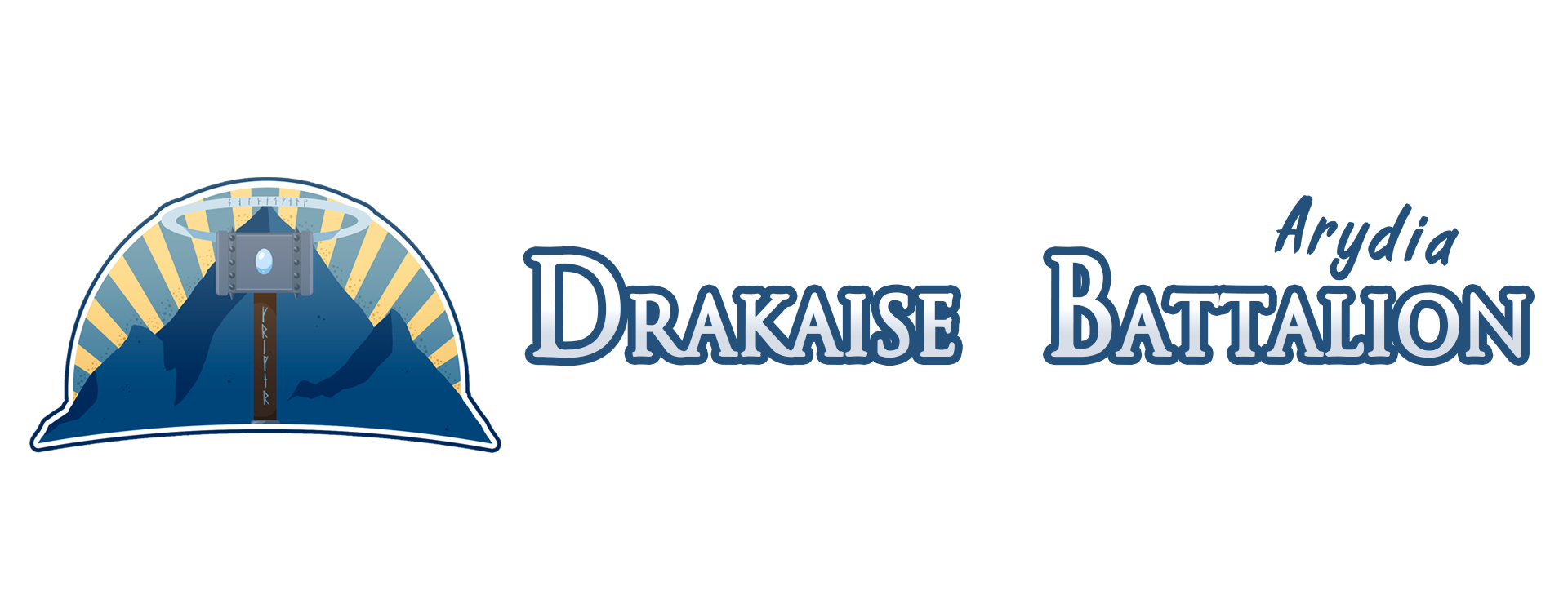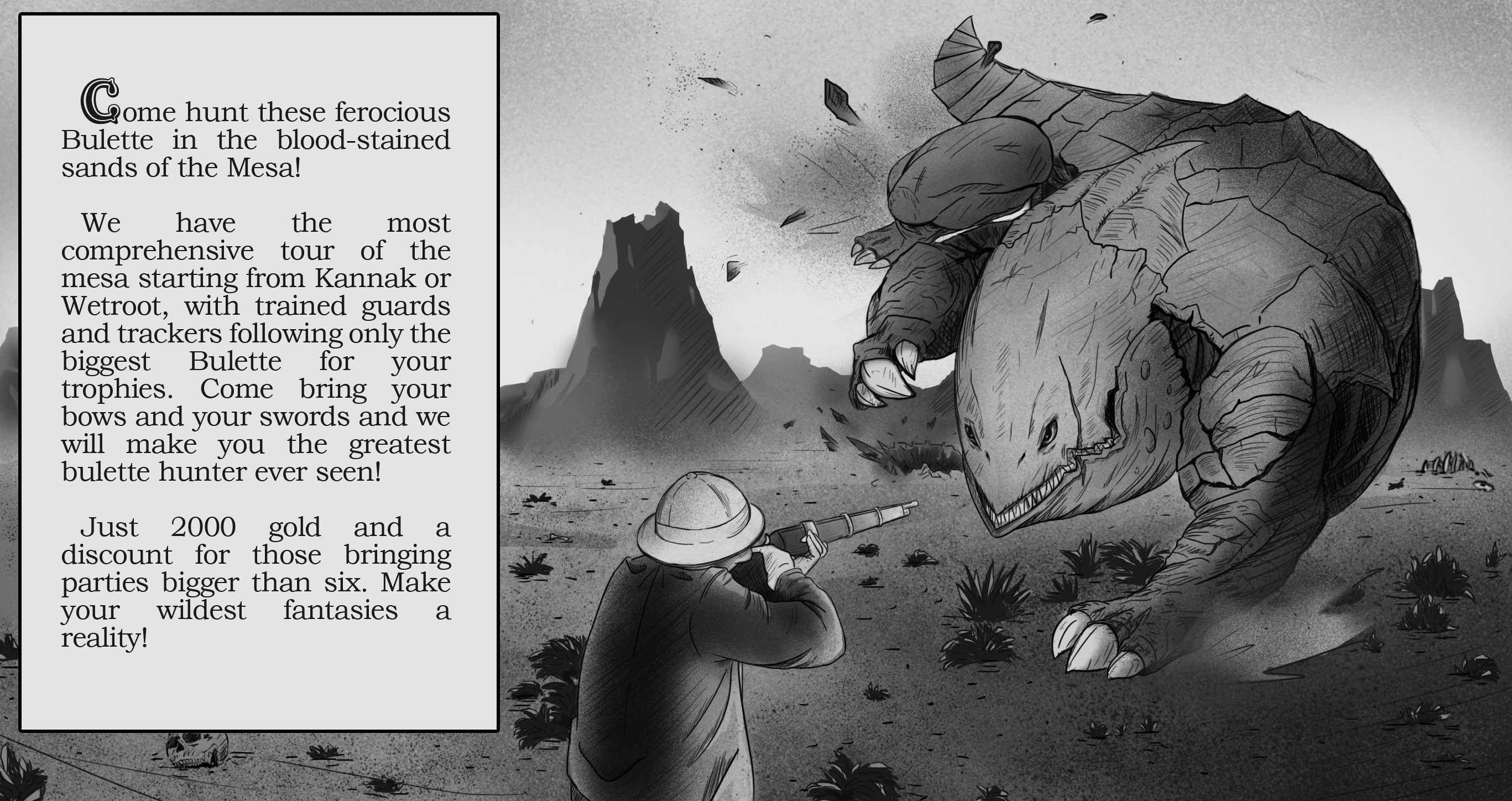Bulettes
Massive fearsome predators that lurk below the ground and prefer Halfling sized snacks.
Description:
Bulettes are 6-10 feet tall with 4 legs and massive chitinous scales that cover all protected parts of the beast. Some of the creatures sport a dorsal fin on top of their shell, which has led to them being labeled as “Landsharks”. These creatures are massive, most larger than rooms and carriages with mouths capable of biting horses in half and vicious enough to do so on a whim.Upon sighting a Bullette, Recommendations are to flee to land with heavy bedrock or walls or trees to avoid the oncoming Bulettes. Should one have compatriots or others with them, one should move faster than they do.
Behavior
Bulettes are burrowing animals that tunnel through anything short of the hardest materials. Due to this, it is hard to construct barriers that they will respect. A large amount of Bulette activity is spent deep in the earth as they are young, toughening up their outer shells with intense pressure. Once they reach adulthood, they are capable of leaping up to 30 feet from the ground and are known as a flying menace.

Bulette Hunting Ad by Eriisoostuff
Life Cycles
Bulettes are birthed in clutches of 60-80 eggs in sealed nests hidden deep under the earth in a labyrinthine nest carved by the mother and father. The eggs give off enough heat to keep the eggs fairly comfortable, in fact; if the nest isn’t sealed enough the temperatures can drop to the point that the eggs desterilize and quickly begin to die off. The number of nests that fail in this manner are unknown, but projected to be fairly few. The eggs begin to hatch after around 2 weeks of sustained heat in the nest after fertilization, the first alive begin ripping into dead and rotting creatures left by the parents or the other, yet to be hatched, eggs. Generally around 1/3rd of the eggs are destroyed in this manner. Upon hatching, proto-bulettes spend their first few weeks of life wandering the enclosed nest and slowly starving as they break down into cannibalistic swarms that kill up to half of the nesting population. Once the cannibalism has begun, the development of the proto-bulettes increases exponentially. At around a week after they have gained their fill from the dead, they begin to secrete a liquid through their skin that makes most materials almost melt as they dig through them. This is thought to provide their tunneling capacity. At this point, they begin tunneling and quickly escape the initial nest. The fathers leave at this point and the mothers expel the proto-bulettes from the nest. Those wise enough begin tunneling into the earth, while those that don’t are usually consumed by the mother. For the next 5-6 months, the proto-bulette will not see sunlight. The mottled grey complexion of the beasts is said to begin here. Deep within the crust of Arydia keeping just clear of veins of magma and other likewise dangers, the bulette train against the elements and their own kind. Often-times a proto-bullette will devour anything they come across. From veins of metal to other bulettes. In fact, it is theorized that the constant consumption of high density proto-bulettes and the constant levels of intense pressure is what helps to form the heavy armor that protects bulettes. Of the initial clutch, only a handful are projected to survive the 7 months of life they go through before returning to the surface as fully grown creatures of mass destruction. Fully grown and capable of devastation, 7 month old Bulettes return to the surface with insatiable hunger born of countless hours with a lack of food and a willingness to eat anything that moves. They quickly establish their own territory, oftentimes killing their own parents to make way for their own time to build nests and start seeking mates. Generally a bulette won't live more than 2-4 years and several breeding program attempts have confirmed that the lifespan of a bulette only reaches around 5 years at max.Locales
Bulettes are found across the continent of Ithungsida; from the northern wastes of Renai, to the swirling red sands of the Mesa to the north-eastern sands of the Southern Desert.Mesa
The hunt was on. We had stalked out from where the caravan had staked up with their guides and incense, setting out to catch a beast for ourselves. If we brought one down, that'd be money enough for plenty. After all, that's why we had all come. Yes, the sun was setting, casting those final amber flames across this crimson desert as we saw it. The rippling of sand, the silent approach of one of the deadliest beasts in Ithungsida. The landshark approached and we readied. I was green then. Never seen more than the corpses carried by the caravan. Thought the incense was fake and foolish. When it pounced from the ground it sent up a flurry of sand like a tornado. Embodying in it's charge, the very fury of nature. And just like that, it had bit one of our traveling partners in half, a poor dwarf by the name of Yar. We reacted too slowly, slicing at the beast as it mowed through us like a halfling at a buffet. My saving grace was a guide that had followed us, he lit one of his incense sticks, burning that fearsome bulette powder, and the creature turned. It did not flee, merely stopped attacking and consumed the bodies it had laid to waste before returning to whence it came. Thirty seconds and five out of seven men were dead. The only blood that night was ours.While Landsharks are found across the continent, when they are spoken of one place comes to mind: The Mesa. Dunes and plateaus carved out of the Feng Mountains, thoroughly infested by a bulette plague of dramatic proportions. Few live in this region, with the city of Kanak being the sole livable city in the region. In this area, ecosystems are sparse. Largely consisting of bulettes of various sizes that battle each other for momentary supremacy. Bulettes, few plants and birds make up the ecosystem. Of course, we can't forget that middling force that shares the spot of “Apex Predator” with the ferocious bulette. That would be humanoids. As often eaten as they kill bulettes, this region is aflow with countless hunters seeking out their fortune in bulette carcasses. The city of Kanak and Wetroot support this trade by offering bounties for each corpse provided.
The Interior / The Coast of Lights
The bug put up a grand fight. We had been making our way through the fields in search of a suitable heater for our village when we felt the tremors from beneath the ice and heard the horrible roars. One of the trap passages fell away and we could see down into the lair of a large bug. The heat flowed out, melting the ice around us too quickly for us to really react. But the spikes at the bottom had melted too. The thing was surrounded by six Icespine, even the youth were almost fully grown. Yet they were corpses and it was still alive. But wounded and resting as it keened it's horrific roars. Calling to the void perhaps as it made out Merkfu in the distance. We snuck up to it and fed three poison darts into a wound on the beast's neck and left with it. Guess we have those Icespine to thank for being alive today, and for getting us such a nice heater for the winter.The icy fields of the Interior and the Coast of lights have bulettes as well, though in much fewer numbers and if a variety found only in the north. The Icespine Bulette are adapted to the region and force a contest of wills with local remorhaz. However, the frenetic chaos that is the Mesa is tempered here, as the Icespine are communal in nature. Hunting in familial groups of 3-6 as they raise their young in much smaller litters before casting them to the depths. This makes them incredibly dangerous as one territory could hold up to 6 Icespine Bulette that may attack you whenever they please. Often times, Icespine are hunted by Frost Giants as they are seen as pests that threaten their breeding stock of remorhaz. This does make the Icespine, and bulettes as a whole, fairly rare in the region.
Southern Floodlands / Highlands
The Floodlands and Highlands of Forkden are conspicuously absent of Bulettes of any type. This has been attributed to a lack of wanting to cross the flooding areas, but is a mystery to be certain when the Forkmaw Range reaches to the Highlands quite easily.Known Variations
Bulettes are largely adapted to underground environments and so rarely show much differentiation from place to place, however, four prominent subspecies of Bulette are known of across Ithungsida; the Landsharks, The Icespine, The Gohlbrorn and the rarely understood Bulbaby.Landsharks
The landshark is the quintessential Bulette. Grey scales, moderate dorsal fin, cannibalistic and intensely Territorial. These dominate most of the continent. The one break for their Territorial nature is when they mate. The parents will generally combine their territory for the month before the proto-bulettes are expelled into the wild.Icespine
Icespine Bulettes are native to the northern wastes of Renai. Generally covered in ice that augments their natural armor and retaining a bluish complexion that isn't far removed from the grey of a Landshark, these creatures act much differently. While still cannibalistic, the young aren't expelled at the same rate. And while they do spend 3-4 months deep in the earth, they often return to the surface and seek out their parents. Not to kill, but to hunt with, it's often been seen that these youth are accepted into most any group of Icespine and become part of the cohesive fighting unit that is an Icespine Clan. Clans will still battle each other, but are generally less vicious than Landsharks, especially when their hunger is sated. An angry or hungry batch of Icespine, however, will destroy everything in their mad search for sustenance.Gohlbrorn
Much smaller in size than most bulette, the Gohlbrorn have a strange and unique shape that almost looks like their natural armor doesn't quite fit. Giving them a shape that mirrors that of a turtle mixed with a bulette. They are still a little bigger than a common draft horse and capable of biting one in half, but the viciousness has been quite bred out of them. In its place is a stark intelligence that rivals that of a man. Don't let their comparatively diminutive size fool you. With keen minds that pick out weaknesses and the use of terrain and tactics to their advantage, wild Gohlbrorn can be formidable enemies. Especially when they are in environments they have adapted to, their burrowing nature influences one of their most effective attacks, which is a ranged boulder collected and solidified in the mouth of a Gohlbrorn before being launched at high velocities. It should come at no surprise that many of these changes were specifically selected for dozens of generations to create these beasts. Many are raised in captivity to be the perfect mounts for a group of “Bulette Riders”, however, after the breed was lost in the early years this new variety has been carefully released into secret places in the wilds of the Feng Mountains. These wild Gohlbrorn are highly communal and intelligent, choosing to maintain consistent food sources instead of succumbing to the rampant hunger of their forebears. As well as protecting local villages and maintaining their populations to avoid being hunted.Bulbaby
Also known as Rock Chickens, Tunneling Bastards, Pains to Farm, and purveyors of delicious eggs. Bulbaby's are the fully domesticated version of a bulette. The secret being to trap a nest of bulette above the surface until maturity, where they will not grow past the size of a dog and they never truly learn the insatiable hunger of their peers. These are grown and kept across KravMaw, Renai, and Araetule due to the high quality of their eggs. However, difficulty in farming makes them less frequently farmed than Chickens. After all, chickens can't dig through stone floors and are unlikely to bite a finger off. However, bulbaby eggs are oft considered a delicacy and a single generally sells for the price of a dozen normal eggs. It is said that escaped young Bulbaby still tunnel deep and undergo the metamorphosis that turns them into whirlwind beasts of death and destruction, this is potentially a source of bulette attacks in more civilized areas.Use in Technology
History
The use of bulette byproducts in technological pursuits dates back a great distance, at least, depending on your definition of technological pursuits… From the early days of Kanak's Bullette Powder to Rexa Thedas and her revolutionary application of using the powder for machinery, engineering and other more technological purposes.Kanak
Records indicate the use of Bullette Powder as a ritual powder as far back as the 200s. However, the powders was rarely used beyond that and use as a bulette deterent.Rexa Thedas
Rexa Thedas has been signified as the “Mother of BP”, she single-handedly caused a revolution in how bulettes are treated in regards to technological pursuits. In 901; she realized and promoted the use of Bulette Powder in outdated weaponry from the time of ancient Araetule In 905; Gunslingers found their way back into prominence with the adaptation of designs to use this powder. In 940; BP Engines were introduced and used to revitalize ancient Trains in SosIwa, at least, until the The Orcish Incursion stalled that. In 973; BP Engines were first used in an Airship and helped establish the first Blood Claw - BS21 which massively spurred development. In 1020; the BP Engine was refined into the BP Turbine which has helped spur advancement to an even greater degree.Additional Information
Average Intelligence
Primal instinctual intelligence closely related to that of a starving wolf infected with rabies.
Table of Contents
Scientific Name
Bulette Sos Sunna
Lifespan
5 years
Average Height
10-12 feet tall.
Average Weight
14-15,000 pounds.
Average Length
7-10 feet in length.
Body Tint, Colouring and Marking
Generally a light grey complexion.




Comments